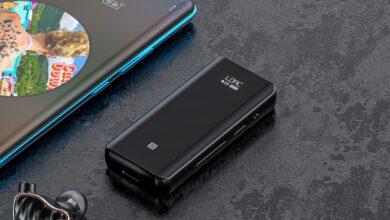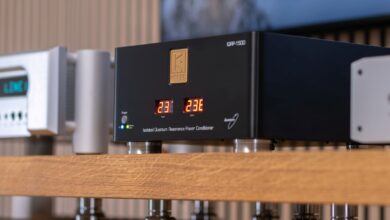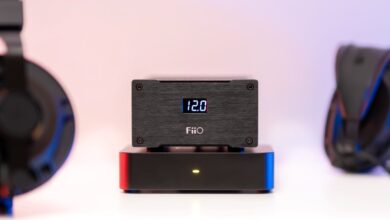FARAD Super10 – The ultimate power for your audio component!
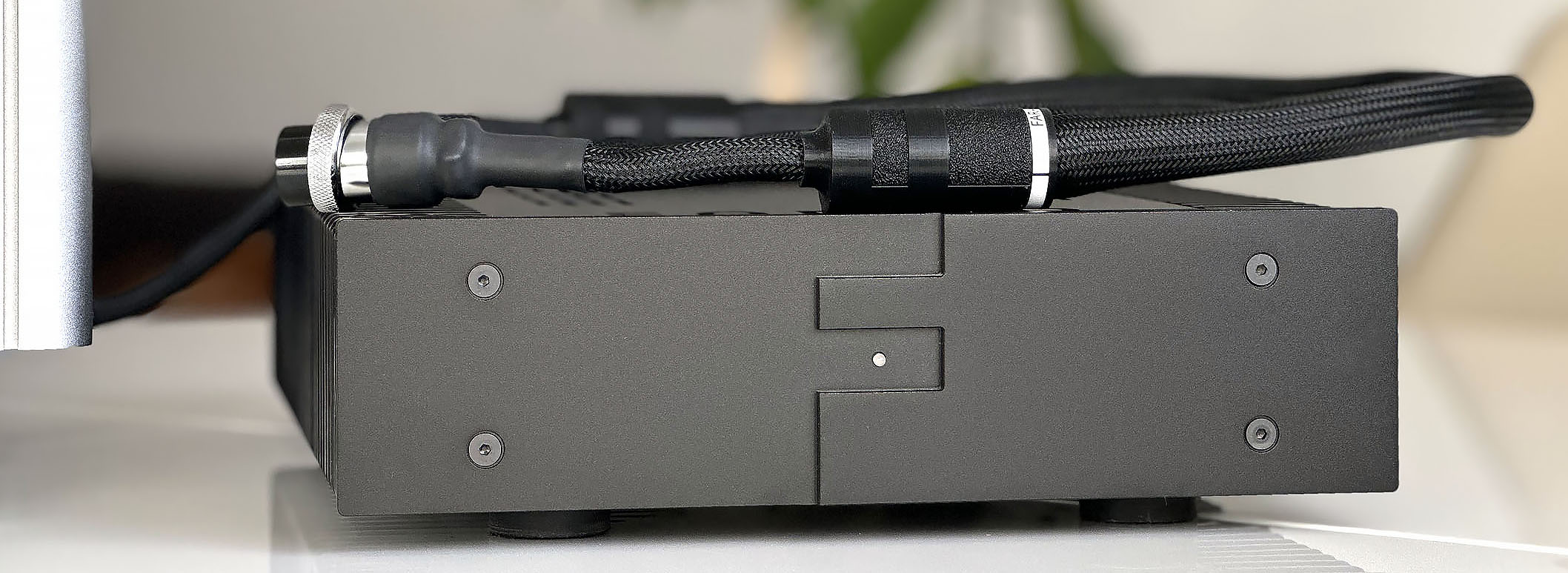
How did it all start?
Well, that is a good question. And it’s a challenging one, as good questions always are. Looking back on my road, it is not easy to tell how I ended up here just a few years later. So many events, detours, stepbacks, and sidesteps make the beginning seem so far away now. So much had happened, and, oh boy… how much I learned and experienced. When the smart ones tell you that the road is more important than the destination, it seems a distraction, a trickery to make you lose focus and even move away from the priced target for a second. Believe it or not, sometimes it is so rewarding to take a step back, take a deep breath, and contemplate what you have achieved. Despite many challenges, setbacks, or dark shades of disbelief, you will be amazed at how beautiful the road looks now. Does it matter anymore how far the destination is? Not so much. The purpose is much more important. The road is what we make out of it.
This is more than just a review; it’s a narrative of discovery, learning, and perseverance. It’s a story about the few, the exceptional, who are continuously pushing the boundaries of extreme audio performance equipment. Their innovation is not just significant; it’s monumental, shaping the future of the high-end audio equipment niche.
One of these exceptional individuals is undoubtedly Mattijs de Vries, FARAD’s visionary leader and heart. With a profound connection to the audiophile community and a rich history of crafting DYI high-end audio components, Mattijs’s journey is a testament to the power of passion and dedication. Mattijs successfully landed a few years back a great product, FARAD Super3, which is still a landmark for high-quality power of audio components. For some time, FARAD had only one perfect product in its portfolio: the Super 3 customizable power supply along with different cable tiers, fuses, and power cables. And it was so successful for good reasons.
Mattijs is not just FARAD’s soul and heart; he is also one of the founders of Pink Faun, a heavy player in the highly high-end, rarefied air of the exceptionally top audio servers market. This is such a small niche that you would not need both hands and fingers to keep track of the companies playing at such high levels.
Because I wanted to start from the beginning, let’s discuss this unique product, the Super3. I hope this will clarify FARAD’s customization and customer care level and provide more insight into the new flagship.
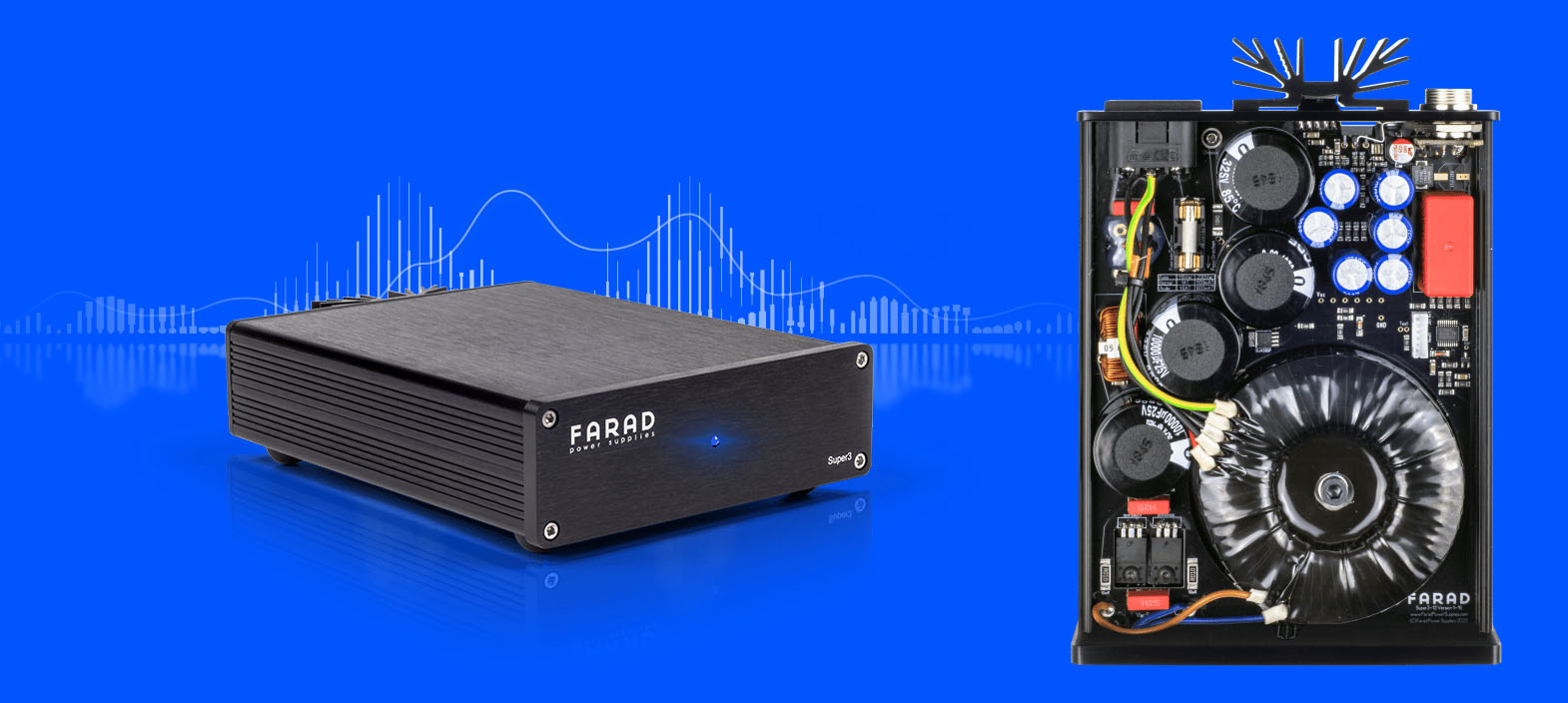
FARAD Super3
What’s so special about a power supply that its purpose is only to provide the required voltage to specific equipment? Why do you even need it in the first place? And cables, really? The fuses? The IEC socket? All are legitimate questions, and I humbly ask you to be a little patient; we will get there.
Why a separate power supply?
This is the first thing that crosses our minds. Why the fuss about powering our devices with anything other than the power the manufacturer provided? Well, the reality is that we live in a world based on economic rules, and every manufacturer has to strike a balance of costs versus the price point to make a profit. That implies some compromises, which usually happen at the lower price point, but not necessarily. Usually, modern audio equipment comes with a switching mode power supply that could be a lot better for the equipment itself and even for other equipment connected to the same power line. And that is because cheap switching mode power supplies pollute the environment with their noise.
And then, an entire community of audiophiles can not be wrong. Not all the time, anyway 🙂 It is known that clean power dramatically affects the sound quality of every piece of equipment. Everything in the audio chain relies on power. That power drawn from the outlet is the actual blood of every system. That power is modified, scaled down or up, modulated, and amplified, and it is the end of the energy that moves the coils attached to the membranes of your speakers.
Upgrading the power fed into your equipment whenever possible will always add huge benefits regardless of the equipment’s price point. Sometimes, equipment powered by a high-quality power supply can scale up above expectations.
“3 Amps of pure musicality”
That is quoted from the manufacturer’s website. And it is so true! Ranging from 5 to 24V, Super 3 carries an enormous punch over the entire bandwidth with an incredibly low noise floor. In such a small package, FARAD succeeded in adding an incredible amount of good things. Three amps are usually enough for many applications, from streamers to DACs, from ethernet switches to phono-stage preamplifiers. It is that versatile. And small, did I tell you how small it is? With just 13cm wide, 17cm deep, and 4cm tall, this superpower source can be easily tucked away. I often saw that at hi-fi shows; the FARAD Super3 was present in many systems. This little fellow did the magic behind the shiny playing equipment.
FARAD even has a voltage change program in place. Have you changed your equipment and need another voltage? No problem. FARAD will upgrade your Super3 to the new characteristics for a minimum cost.
Hf Pi-filter smoothing section
Super3 has low ESR capacitors and High-Frequency common mode choke filtering to reduce ripple and Hf noise from the mains. In total, there are six pi-filter sections before and after regulation. The double regulation and supercapacitors entirely eliminate low-frequency noise.

Custom wound transformer
A cast triple-shielded high-inductance transformer for a high supply duty cycle, low rectification noise, and very low AC leakage current. OK… what does that all mean? This means a high-quality toroidal transformer will not pass back any internal or from the connected equipment noise to the power outlet like many switching power supplies. The transformer is dead silent and has very few fluctuations in voltage.
Super Capacitor Power Bank
That is the cherry on top of the cake—it really is. This bank of supercapacitors acts like a virtual battery, supplying the final low-noise regulation with stable, clean power. Supercaps tuned to the power supply voltage provide a capacitance of 1F (1.000.000uF) to 3.3F (3.300.000uF), depending on the voltage. And that is huge! All this results in pure DC voltage with the lowest noise floor possible over the entire bandwidth.
Super3 in a nutshell
A well-designed circuitry, intelligent PCB design, grade A components, a sturdy aluminum housing, and the drive to bring out something special in any sound system make up for a nifty and potent supercapacitor linear power supply with a tiny footprint that will find a place in even the smallest of environments.
“It’s not a case of throwing in some premium components and expecting instant success. They need to work in harmony to get an optimal result. It starts with a clear concept of goals and how to achieve them, thorough testing by measurements, and many hours of listening,” says the FARAD team on their website.
Oh, so they listen! That is why you can customize the excellent Super3 with the required voltage and the AC Inlet, fuse, and DC cables. FARAD actually listens to its products and searches attentively for the best-sounding pieces of the puzzle.
AC inlet and fuse
You can buy it with a Furutech Rhodium AC inlet. There are also many options for the gold-plated fuse in a holder with gold-plated contacts, from Synergistic Research to Quantum Science Audio. Why all this “madness”? The power supply’s performance can be improved using the right cables and fuses. Better conductance from point zero onwards leads to better performance.
Tech talk
If I raised your interest by a notch, I recommend you follow FARAD’s answers to the most common tech questions here. You will learn why using an ultra-low-noise regulator, praised by so many others, does not mean the supply is ultra-low-noise, why FARAD uses the supercapacitor power bank, and why their power supplies only have one fixed output voltage. Captivating stuff.
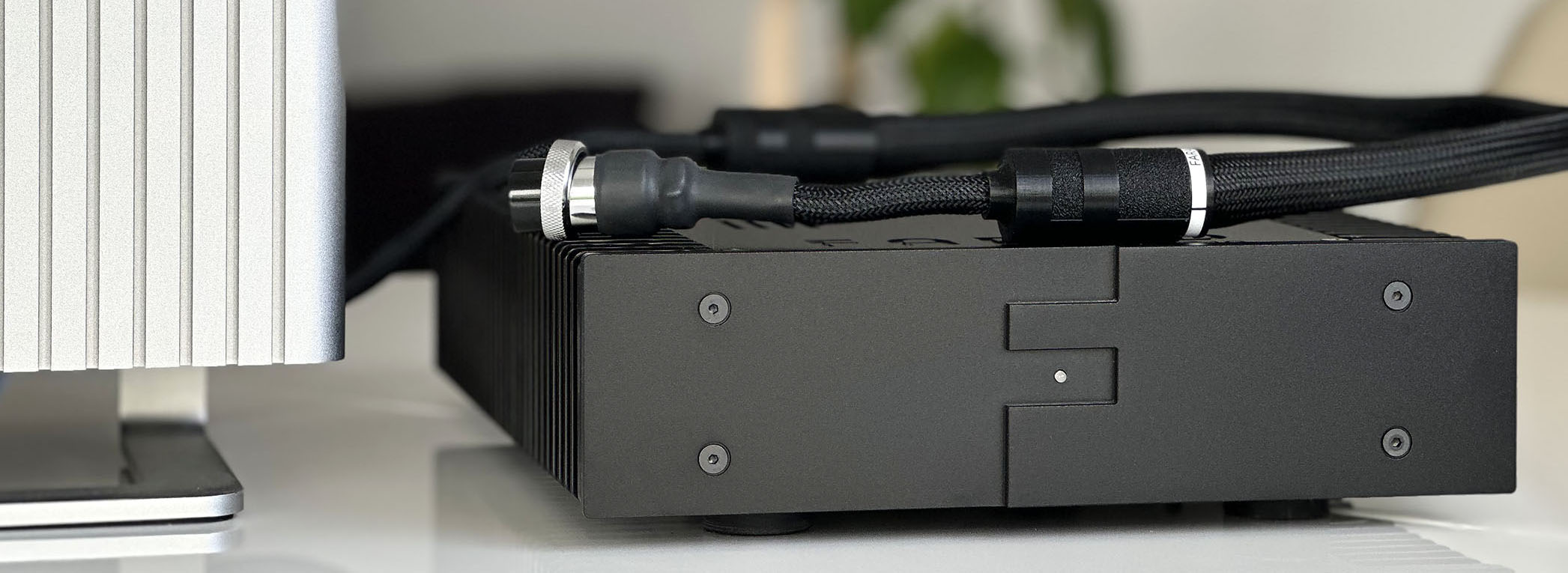
One last word
I have long been impressed by Super3’s technical elegance and incredible quality in such a small package. The attention to every detail, the construction quality, and the level of customization are just perfect. When I started my DIY project, I already had 2 FARAD Super3 power supplies in my system. The impact on sound quality for my streamer and switch has been proven for some time.
The sound improvement brought by FARAD Super3 was always palpable and perfectly audible. No matter where I used it—with my Melco N100 streamer, on different switches coming for testing, or on DACs—Super3 always provided splendid sound quality and significantly improved over the standard power supply. This little power source proved itself again and again. The result is more extension, a more dynamic sound, sweeter highs, and better tonality. Every time, you could hear an effortless sound reproduction, a smoother and more dynamic presentation.
The price point of FARAD Super3 is quite decent, more than acceptable for the product quality. Starting at € 559 + VAT, it is a highly competitive price for what it offers. Adding a Synergistic Research Purple fuse at € 181 and an L2 silver or copper cable for € 229 will almost double the price, but you could always perform these upgrades later. Even at € 969, I would say the price is still competitive for the whole package. Of course, many cheaper power supplies are out there, but we are talking about a top-notch product of a higher quality that will significantly improve your system. This is not a small step up or an attentive listening granular improvement. This is sometimes a night and day difference!

Next step
The audio server
The idea for building something like that came from realizing the massive impact of the power source on my standard NUC running my Roon Core. Yes, I used a long-time Roon Nucleus, and I powered it with different sources, from the included switching mode power supply to various linear power sources. I could not use FARAD Super3 due to the limited power; the i7 NUC requires at least 85W. And yes, the annoying part of this is that all that power is only needed on some spike moments at startup; in everyday use, the Roon Rock will stay in the 2 Amps range.
Every time I changed the power source on the Roon server, I could hear an impact in sound. I did not expect that because, again, the Roon Core was not connected to my DAC; it was just a server with the only purpose of hosting the Roon Rock and sending and syncing the music with Roon RAAT protocol over the network to my streamer, whatever that would have been. I mainly listened on headphones back then, and I could say without modesty that my system was highly revealing. Let’s remember the setup:
- Headphones: HiFiMan Susvara and Meze Elite.
- Headphone amplifier: the monstrous and highly dynamic and musical Trafomatic Primavera tube amp.
- Chord Mscaler going into Chord Dave DAC.
- Melco N 100 as the streamer.
- Melco S100/2 as the network switch, connected to the Roon Nucleus by optical network cable (with a media converter attached at the server side).
- FARAD Super3 power supplies for Melco streamer and switch.

Many experiments later, I realized it was time to “put my belly on the book.” Yes, it may sound strange, but this is a common expression in Romanian… meaning you have to start to learn seriously, dig in the library, gather some serious knowledge, you got the idea 🙂 I began to read hundreds of pages from forums (AudiophileStyle forum, an incredible source of information) and dissect all the pictures I could find online of the real well-regarded music servers like Pink Faun. In short, I reached some conclusions on what it has to be a serious audio computer or music server if you like:
- Power, power, and power! These are the first, middle, and last characteristics of these machines. Nothing could replace the quality in terms of cleanliness and stability of the power feed into the computer. There is also power separation; it is highly recommended to use multiple power rails, keeping the components as separated as possible. An excellent linear power supply will ensure power quality with minimum noise and no pollution to other equipment from the noisy computer itself or between the components.
- The wiring quality is also related to the power. Good copper wiring with shielding will help keep the noise generated at bay. Many will go to the extreme and use very high-quality silver wiring for all the power lines.
- If the server also acts as the streamer, dedicated components for Ethernet and USB mean high-quality network and USB cards (SPDIF, I2S, or any other type of digital output). Again, a separate and high-quality power supply for each board is mandatory. These unique dedicated boards are much higher quality than standard components integrated into the computer motherboard.
- Clocks. These can be integrated into dedicated Ethernet or USB cards or even higher-quality clocks, kept as independent components and powered independently. However, upgraded clocks are a must for the I/O streams. Some will even upgrade the clocks from the motherboard, but that requires a lot of skill and knowledge.
- Passive cooling — this is somehow implicit. There is no place for a noisy, vibration-producing fan source inside the audio computer. All music servers should use passive cooling with appropriate, generous cooling surfaces.
- Software: optimized and dedicated software should be used for running the server and streaming part of the system.

Of course, there are a lot of other details where the devil will feel at home. Years of tickling with different components and architectures from the DIY community will provide an invaluable source of information. This is how FARAD was born, from testing various power solutions repeatedly for the highest sound quality possible. Mattijs de Vries had built power sources for these custom-made and extreme audio computers for many years, and all that passion and experience gathered throughout the time is irreplaceable.
A little bit smarter now, I started my DIY audio server project. I did not venture into the streaming part as I quickly understood the necessity of almost doubling the power sources, clocks, and budget in the end. I kept my project limited to a Roon Core server, and I was pretty sure that it would bring the expected benefits. This is how my Roon server was born, and let me tell you more about each decision’s reasoning:
- FARAD Super10 is the best-quality power supply that I could find, with 10 Amps of power as a single source.
- Intel 12th generation gaming motherboard — A gaming motherboard will add the extra benefit of power stability even under high-stress conditions. These motherboards are built with extra care for overpowering, better components for overclocking, and higher flexibility for tweaking.
- Intel 12th generation processor — i7-12700. It was essential to keep the processor’s power consumption limited, as the passive cooling capacity is somehow limited and not scalable. This processor can run most of the time on a 65W power range, even if it scales up to 200W instantly. A good power source will ensure short-term scalability, and even if spikes can appear during the booting process, they will not impact the cooling capacity.
- 32 GB of RAM — APACER. On forums, many brave testers concluded that industrial-grade memory (preferably with ECC) would sound better, have better overall stability, and have a lower noise floor.
- 512 GB high-speed SSD for the operating system and 8TB for music library storage.
- Passive cooling Streacom DB4 case, capable of 85W of passive cooling. And I thought it looked great!
- HD Plex 400W ATX DC fanless DC-ATX converter with top-grade components and dedicated ripple noise-suppressing circuits. A much better solution would be to use separate power supplies for each rail, but that was too much for me. I decided to use the already-mentioned DC-to-DC converter from HD Plex for a single high-quality power supply.
- Neotech OCC copper wiring, 18AWG with JSSG360 double shielding.
- JCAT Net Card XE is a dedicated network card with a separate power supply and a high-quality clock. A high-end network audio interface with two ethernet copper ports allowed me to separate the server internet connection from the streaming connection, creating a separate network for the streaming part.
- The JCAT Optimo Nano power supply reel is designed to filter and enhance power for low voltage—5V. It separates the power for the network card and SSD used to store local music files.
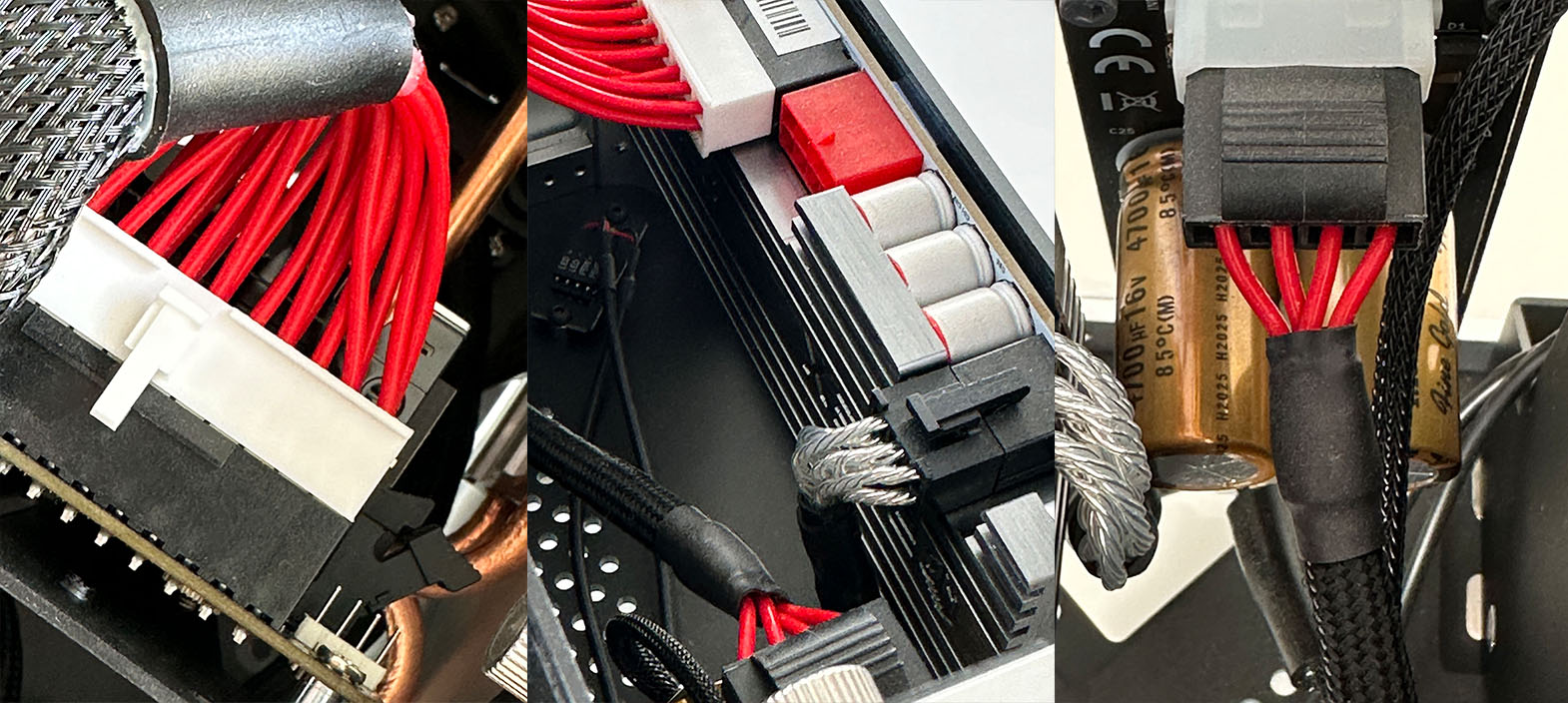
I only started with some of this in place. I built it piece by piece, and by doing it that way, I had a chance to test each improvement at a time. I started with the standard wiring provided by the motherboard package and a standard switching mode power supply. I upgraded to the Neotech OCC wiring and JCAT Net Card with Optimo Nano power supply. I tried a few linear power supplies and had difficulty keeping them at decent temperatures. Even supplies declared to work at 8 Amps proved to not be up to the task and working extremely hot. Some did not even pass the bootup procedure, which produced spikes of 8 Amps. Finding something with proper headroom and stable enough for decent temperature conditions was difficult. Of course, a switching mode power supply will not have all those power scalability and heating problems, but the generated noise will kill the purpose of an excellent musical server.
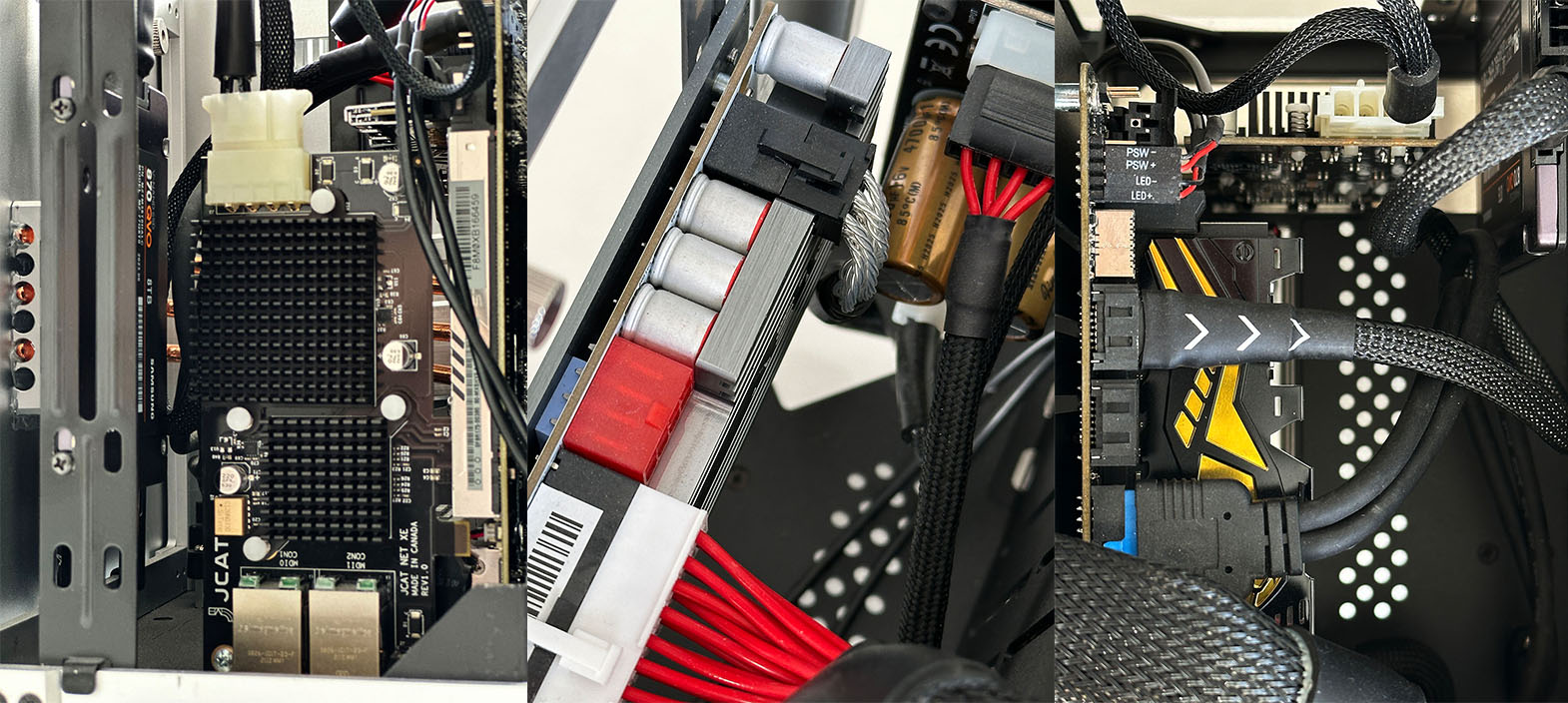
And then I remembered. FARAD started to work on a new product: a 10 Amps power supply called Super10. Based on my experience with Super3, I was confident that Mattijs knew what he was doing. I also remembered that I already had a conversation with him in my email about a voltage switch request. Mattijs answered my website request and guided me on packing and sending back my Super3 to FARAD headquarters for a voltage change. I was impressed back then that I got support from no other than the company’s owner. That was impressive and demonstrated how much FARAD cares for its customers. You do not see that very often, especially for an already-sold product. Remembering all that, I gathered all my courage and wrote to Mattijs asking about the availability of their new power supply.

FARAD Super10
This was when I was proud and satisfied with my DIY endeavor. It was so much more than I expected. It was a real breakthrough. Mattijs answered my email generously, and within two weeks of my first inquiry, I got the new Super10 perfectly packed at my door. Mattijs has also included with the package their top tier silver cable for Super10, an incredible named Level 3 cable for proper testing of their new product. And not just one, which is completely custom for the DC-ATX converter, but another one with 5,5 usual termination. I can tell you these cables complete the high-quality power sources from FARAD and level up the actual possibilities of the power sources. These cables are not an afterthought; these are part of the product and have an attentively studied effect on sound performance. FARAD’s website goes to great lengths to explain the perfectly audible differences between different levels of copper or silver cables. Again, these guys are really listening; they still have the passion that started all this, and above all, they care!
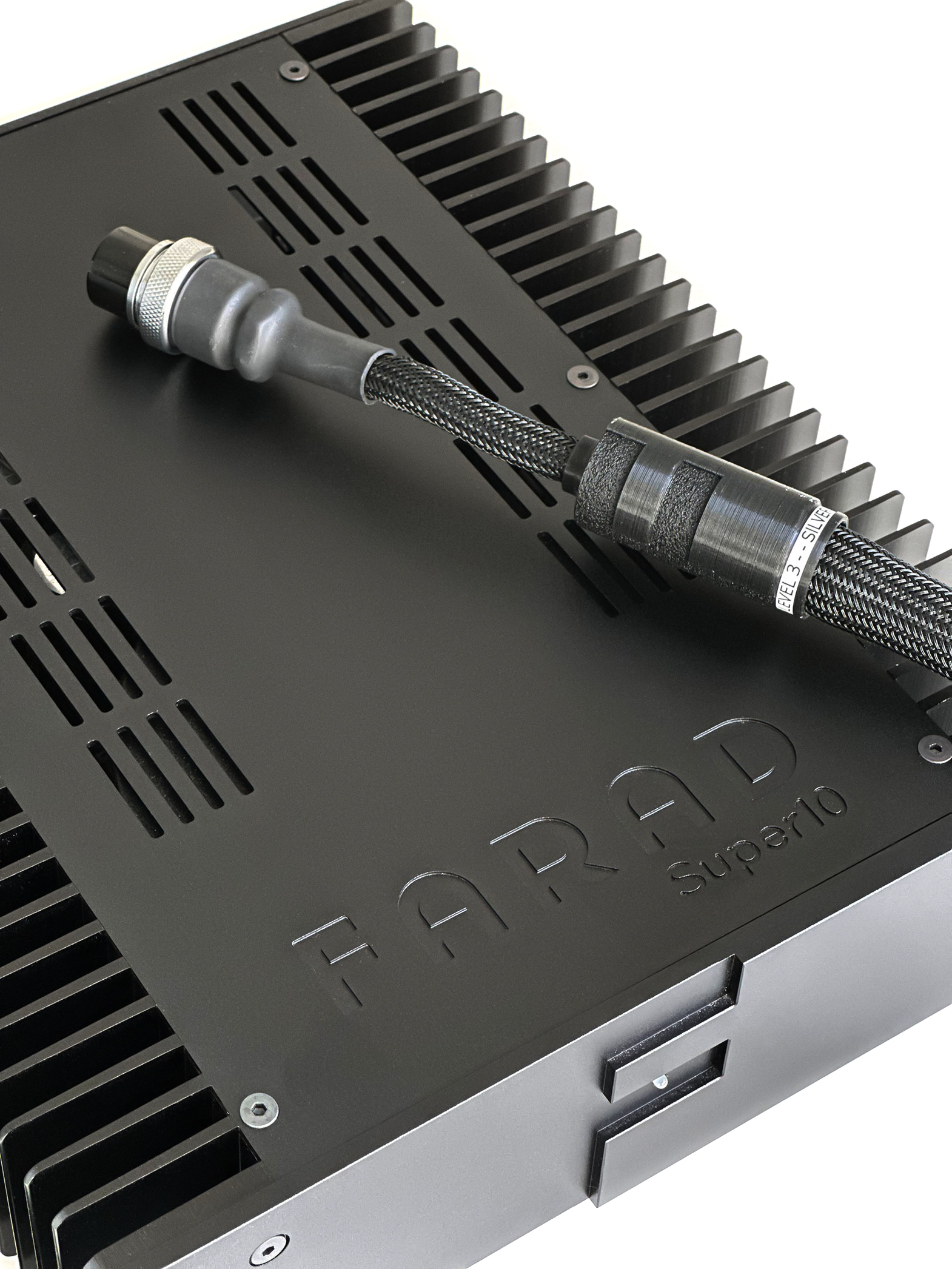
Unboxing, Design & Build Quality
FARAD Super10 arrived well-packed in a much larger box than I anticipated. The power source itself is, in reality, an uncompromising approach as a flagship product; it has the size and weight of some compact power amplifiers. The chassis is made from thick black anodized aluminum plates, and the side panels are solid radiator fins. The half-centimeter thick front and back panels added to the impression of a solid piece of equipment. Compared with the Super10, the baby Super3 is almost three times smaller in all directions.
In addition to the mentioned physical characteristics, the Super10 looked and felt like I forgot to switch the actual power button once powered. The quality of construction and the completely dead-silent operation are staggering. No sound can be heard, even if one sticks the ear on it. The temperature is constant, almost cold; it does not even warm up. After a few days of operation, the metal is not so cold anymore; it feels like room temperature. That was incredible as other expensive sources tried before reaching dangerous temperatures, almost 65 degrees Celsius, not to mention a constant faint hum that can be heard once you listen closely. That’s not the case here; FARAD Super10 looks and feels like it is turned off; if it weren’t for the front panel blue LED, I would say it is not powered. The uncompromising approach can also be seen on the back plate where not only the power socket from Furutech was mounted with a built-in fuse holder, but the fuse used is the Synergistic Research Purple 6.3A, 5x20mm. This is coming standard on Super10 and not as an option like on Super3. The show on the back will continue with the giant, four-pin GX25-4 DC connector. To the left, we can find a button that allows us to restart the controlling microprocessor, which is required when switching different receivers, running the procedure, and adjusting the parameters to match the attached device. Next, a switch controls the trigger mode selector, and a 3.5 mm socket is used to interface with other equipment (to trigger the power on different devices). There is also a switch controlling grounding (Flow/Earth) and a dedicated clamp for the ground wire. And that was only the minimalistic exterior.
Inside is another story, far more complex. Half of the vast chassis is occupied by the hand-wound custom toroidal transformer, enclosed in a dedicated metal box and double-isolated. There is no question now why it is so dead silent, and it is accompanied by a coil eliminating any hum or EM fields. Further, we can see a battery of capacitors with a total capacity of 72.000uF and an additional bank of supercapacitors (EDLC) with a capacity of 16.7F. We can find a low-noise regulator with current compensation and a low-pass filter (for high frequency) using foil capacitors with very low ESR on the output part. Let’s dive into the details for a minute.

Active current compensation — Super10 incorporates an active current compensation circuit, which corrects the voltage drop in the output, PCP traces, and cables. This reduces the voltage drop at the load when current needs to be delivered, resulting in a rock-steady sound on any load. Plain and simple, the headroom is so significant, and the activity compensation is so good that regardless of the current drawn by the connected equipment, Super10 delivers the same voltage unfailingly.
Foil output stage — The Super10 has a 230uF foil capacitor output stage, combining MKS and MKP capacitors for optimal operation and ultimate sound quality. No electrolytic capacitors are used, ESR is very low, and HF filtering is very high. The result is a pitch-black background and ultimate speed delivery of voltage peaks over the full bandwidth. We hardly see that even in the output stages of very costly DACs, pre- or power amplifiers.
Shielded transformer & Choke — In Super10, FARAD has potted and shielded the custom-wound transformer and choke to eliminate even the most minute hum, buzz, or negative influence from the magnetic field to ensure a dead-quiet operation and completely undisturbed DC output. Indeed!

SR Purple fuse & FI-09 NCF Furutech inlet — The Super10 comes standard with a Synergistic Research Purple fuse, proofed to open up the potential of the power source fully. No highlights, no artificials, nothing more than a beautiful performance across the entire bandwidth, with a sound that can only be described as very real. The world-renowned Furutech FI-09 NCF inlet is also the standard choice for Super10. With its mechanical and electrical stability, low noise floor, detailed sound, and ultra-stable image, FI-09 NCF is just a natural partner.

Testing environment
As mentioned, I tested it first on my headphones system described earlier. Later, when the speaker system started to look more serious, it became more critical than headphones and more revealing for the soundstage and layering characteristics. This is my actual reference system:
- Raidho TD 1.2 speakers
- Chord Ultima 5 power amplifier & Chord Ultima 3 Preamplifier
- Mola Mola Tambaqui DAC
- Lumin U2 streamer (Roon only mode)
- Lumin L2 switch
- my custom DIY Roon Core powered by FARAD Super 10
- Melco S100/2 switch on server side powered by FARAD Super 3
- Marohei Statement SE speaker cables
- Marohei Statement SE XLR interconnects
- Marohei Statement SE power (DAC), Roboli Charlin power for the rest
Heads up
Before discussing sound quality and impressions, all considerations are based on my system, room, and experience. This could be helpful as a general guideline but may only be partially reproducible on a different system. The revealing capabilities of all as a unity are critical, and always remember that your system is as good as the weakest part of it. Good transparency and a properly unified level of all involved equipment from the chain are not just recommended but critical for a correct analysis.

Sound Performance
After so many words, we finally ended up where we cared the most. Thank you for being patient and following me all the way.
In the headphone system
After many changes with internal wiring and many power sources, I was disappointed in the system’s instability and sound signature. Before FARAD’s arrival, the sound was speedy indeed, but I could not escape some harshness and brightness. I knew the power source dramatically affected the sound, so I did not give up.
FARAD Super10 power supply finally arrived, and it completely changed the game. Mattijs recommends in the attached literature an approximate burning time of 500 hours. FARAD also recommends taking some breaks during the process and letting the power source off (8 to 12 hours) between the listening sessions in the burning period. All that makes a lot of sense from the perspective of the foil capacitors and other components used. I also encountered this advice from manufacturers of valve amplifiers. The attention to such details from a power supply manufacturer is still not usual. This is a sign again of great care and respect for their work, product, and the customer.
I followed Mattij’s advice; indeed, there were variations in performance, but nothing in the wrong territory that I knew so well before. Super10 sounded incredibly good from the start—no more harshness or bright sound. The dynamic character changed significantly during the breaking period, but at least I was way out of the digitus territory.
I need to remember a comparison. During the building period of my Roon server, I tested an exciting product – Innuos ZEN Mk3. It was an excellent product that left some marks on my mind and impressed me from many perspectives. ZEN Mk3 can be a Roon server and Roon streamer at the same time. First, it was blazing fast; I was impressed by the remarkable immediacy of sound. It was also impactful but mostly very detailed and had the fastest transients I had ever heard of. Chord Dave transformed into an incredible life-like monstrous instrument. Later, I missed that natural aspect of the presentation with my new server before landing on FARAD Super10.
FARAD Super10 restored the feeling of immediacy and naturelessness of presentation. I was so happy, and I counted it as a big success. The server did not sound mellow and bright anymore. Later, the sound became even smoother, and I sensed a significant improvement in dynamics. It was so close now to the ZEN Mk3 that impressed me with those attributes.

Layering, details, and timbre
The layering is perfect with FARAD Super10, and the sound is spectacularly palpable. Layer after layer of details, everything is perfectly audible. Being very fast, the sound has a natural timbre and an uncongested reproduction. The flow of information is free now, without any trace of harshness. I have a few audiophile fellows coming to listen to headphones on that period. I was so excited that I invited all my good and passionate friends to test the system. The general conclusion was that it sounded so natural and revealing that it was spooky sometimes. The speed of transients tends to lead to an incredible naturalness of sound and also plays a significant role in timbre. A natural timbre is highly dependent on speed. Everyone agreed that the transparency was off the chart.
The soundstage and stage positioning
Super10 did even another spooky thing in my system. The stage grows a lot with HiFiMan Susvara. Being top-of-the-line in speed and transient reproduction without the overly detailed and excessive upper register of other headphones that try to impress you in that respect, Susvara is recognized in a different measure for its soundstage. Not that it is small, not at all, but not entirely on par with other extraordinary qualities of this headphone. Susvara is a dynamic monster, the most detailed headphone on the planet, with a natural timbre that never exaggerates the upper-frequency range, but it is not a sound stage champion.
With Super 3, the stage became much more significant. It has grown substantially, coming so close to Meze Elite, for example, a true king of staging and fabulous midrange. The difference in stage size was a lot smaller now. Susvara started to sound big, very big. Being driven by the Trafomatic Primavera with enormous power reserves, the sound was utterly free now. Mark my words; I have never heard of a more transformative beast like Susvara. These headphones change so much with power and good signal quality like no other.
With the soundstage, holographic three-dimensionality and palpability of sound become much more apparent. It shows now what a good valve amplifier can do to sound positioning. Everyone was impressed by how big and 3D the sound was reproduced.
Dynamics
Dynamics varied widely during burn-in, which was the most apparent aspect of transformation over time. Ultimately, it stabilized in a sensational, punchy, and expressive sound. The dynamic is tremendous with FARAD Super10, and I have never heard Susvara pounding so hard and so deep on a headphone amplifier. The bass is rewarding and very well-controlled.
I know it may seem strange to attribute all these qualities to the server’s power source alone. But let’s remember what started all this madness. It was a dramatic change in dynamics with the power fed into my Nucleus Roon Core. That was the trigger, and dynamics was the most sensible aspect of changing the power quality. I expected that; I hoped for a miracle here, and I was not disappointed.
After many hours of changes, smaller and smaller variations in sound impact and bass control were audible. FARAD Super10 reached an almost peak potential, and the bass was more controlled and sounded bigger and more profound with a different layering quality and more sound texture. It was a painful transformation as I had glorious days followed by not-so-colorful ones. I had to remember and reread the leaflet from FARAD – 500 hours of burn-in time and regain hope.
The bass is now correct and tremendous when called upon. It is no longer exaggerated or shallow when one expects proper pounding. It is just right, going deep, detailed, and natural. Well, dynamics is about more than just bass. The instruments always sounded fast, and the attack was much less affected than the bass. That is why the bass qualities were the easiest to compare.

Effortless
This is my first differentiator if one asks the most significant difference between a good sound and a state-of-the-art reproduction. A high-end sound will always be apparent by effortlessness; you always feel that the system can do it better and better, and sound reproduction has no obvious limit. You hear unexpected extensions on both margins of the spectrum, something you never heard before on that particular track. The sound is voluptuous, big, fast, and transparent. A black background of a very low noise floor will help a lot with the effortless reproduction as the sound is coming from nowhere, from deep blackness; it has a perfect contour and is precisely positioned. You do not have to listen for all that; the effortless sound is usually shocking and quite apparent.
The primary constructors of effortless sound are the big sound stage, lightning-fast transients, and extreme dynamics in a black background. This is the most beautiful part of perfect sound reproduction. You get used to it quickly as it is so natural. And then you drift entirely into the music, forgetting to change the track or listen for something unique. You will go with the flow and forget about it all. Returning to a lesser sound could be pretty painful, so I must warn you!
Yes, FARAD Super10 provided the most beautiful, detailed, transparent, and effortless sound I have ever heard. This power supply’s sound qualities are simply astonishing.

In the speaker setup
I am confident this power supply will have audible effects anywhere in the audio chain. It could be even more critical and palpable elsewhere in the chain than powering an audio server. Or not… Many will say that “source first” is not just a slogan. But I think the impact on a DAC or a streamer will be immediate. It is a presumption because I did not test it on other equipment. I chose 19V voltage, an unusual value mainly used in powering computers.
By the time I concluded my speaker setup in a more stable format, the Super10 was shining already, and I was so thankful for what I got from it. It was a proper source that allowed me to build confidence in the speaker system. I recognized the same qualities but more rewarding this time. We must admit that speakers provide a more coherent and credible sound stage. The impact and dynamics of a speaker system are more physical and tangible.
FARAD Super10 provided an effortless sound foundation and extreme natural dynamics. I can now test various equipment, confident that I have a solid, high-quality playground.

The whole system is as good as the weakest part of it.
I have to remember that all the time. Maintaining a level of performance across components, cabling, network sources, and so on, is essential. Not that it has to be necessarily expensive. It must be clean, and we must consider everything involved in the audio system, from power to network, from streamer to power amplifier. Most of the time, a sound system with reasonably priced components but attentive put together and sought upon every piece will sound dramatically better than a system chaotically arranged with astronomically priced equipment but without any synergy or ignoring the trustworthy source of the music. That is why I put so much effort into building something that can provide a good foundation: a custom server with aligned components, a good power supply, an independent network for audio, and optical galvanic separation.
Power is essential everywhere in the system; it is the true blood of the audio system. What is terrible at the source just gets amplified. Take care of the source, analog or digital, and you will be rewarded with the transparency needed to compare, test, and decide. I mostly discovered this in the speaker system. The speed, transparency, and naturalness offered by the source allowed me to hear things that I could not before. I could hear a new analog interconnect and, yes, the effect of different power or digital cables. Everything was now unaltered, and the system sounded as good as the weakest part would allow it.
I was surprised and grateful for the highly detailed sound that digital streaming provides with FARAD Super10, mostly because of the lack of harshness, digital glare, and fatigue associated with a digital source compared with a more forgiving analog one. I could hear now the difference between a separate network path, directly connected and provided by the server, and a connection shared by all the devices from my house. I could not hear that before.
FARAD Super10 added great speed and attack and a better and more lifelike tonality. The details were no longer high-pitched and forcefully fed to the power amplification. The sound had more impact, space volume, micro-contrast, and macro dynamic; it sounded big and powerful. I could hear the music much louder now because the sound was smoother and sweeter. The dynamics were natural and not bloomy; the highs were not piercing but impactful and natural; the midrange was not shouty but silky. The sound gained weight, texture, and a lot of immediacy. The feeling was of a far better system, with a few notches above, more real, and with a more mature sound.
I could hear the differences in DACs and streamers with FARAD Super10, which allowed me to choose the right product for my system. It was a far more conscious and educated decision, not based on just the colorful change added by any component. For the first time, I could hear precisely what any changed component was doing, and I could not hear a difference anymore between the local streaming and Tidal or Qobuz streaming. Or at least not a relevant one. Of course, differences in bit rate or master album versions are now evident. For the first time, I started to acquire digital files in DSD format and build a local library. Because I could adequately understand what DSD is and how it sounds.

In conclusion
I could not compare all the top-rated power sources out there. But from a few that I tested, the conclusion is quite clear. From noisy, harsh, and digital-sounding cheap switching mode power supplies to expensive but underpowered linear ones – despite their promising technical details, FARAD Super10 proved to be a revelation. Not only is it mighty, but it is also incredibly clean and quick. It provides a more than generous headroom, proving once more that in sound reproduction, there is no such thing as “good enough.”
The build quality is exemplary, the attention to detail for each component is jaw-dropping, and the included premium accessories in this top product are just another guarantee for a top-of-the-line product, a real flagship. You can use this exceptional power source in many places, and it will pay big in the end regardless of whether you power a switch, a DAC, or a streamer—or even a server if you feel the need to venture into DIY territory.
The price of FARAD Super10 starts at € 2889 and includes the SR Purple Fuse and FI-09 NCF inlet. The L2-C cable is also included. You can customize it with a better fuse and a Level 3 silver or copper cable. This is not cheap by any means, but it is definitely a top-tier product. FARAD is available in Romania through the AV Store, one of the largest retailers in Eastern Europe. For more information or a direct buy if there are no retailers in your area, just hit the FARAD website.
SoundNews Gold Award
I want to thank FARAD for their exceptional customer service and for giving me the opportunity to test the Super10. For all these reasons, I am more than confident I can award FARAD Super10 power source with our Gold Award. Thank you, Mattijs de Vries, for your kind generosity and trust.




